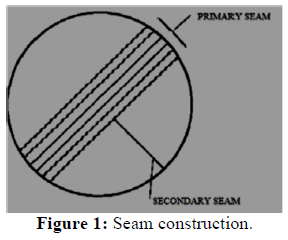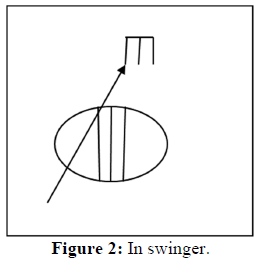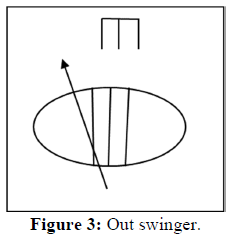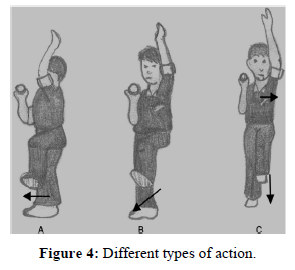Research Article
A STUDY ON FACTORS AFFECTING SWING BOWLING
4144
Views & Citations3144
Likes & Shares
Cricket is a game of very complex actions involved in executing the skills such as fast bowling, swing bowling. This study focuses on the swing caused by the fast bowlers which has not only fascinated the bowlers who practice it but also the researchers and the fans who watch the game. Here the author discusses the natures of this trade that is swing bowling and the factors affecting the attainable swing from a delivery.
Keywords: Cricket, Swing bowling, Aerodynamics, Weather conditions
INTRODUCTION
The aim of swing bowling is to cause the ball to move in the air or 'swing' whilst delivering mainly fast-paced balls to the batsman. The different forms of swing are in swing, outswing and reverse swings which are discussed later in this article. Research already done on the reasons for causing swing like principle of boundary separation or lateral deflection, aerodynamics and Bernoulli’s theorem are discussed in this paper. Also, the other significant factors such as seam, shine, speed, weather conditions and the action type which assists swing bowling are also discussed. (Cooke, 1955) was the first researcher to work solely on cricket ball aerodynamics.
DYNAMICS INVOLVED
The dynamics involved in the process of a swing are principle of boundary separation/ lateral deflection and aerodynamics. Many previous researches in sports ball aerodynamics such as the ones made by (Fara, 2015; Strutt & Rayleigh, 1877). Credited “Magnus Effect” for this lateral deflection.
(Prandtl in 1904). Introduced the boundary layer theory and characteristics of boundary layer were later accredited as the primary factor affecting the aerodynamics of a cricket ball.
LATERAL DEFLECTION AND PRINCIPLE OF BOUNDARY SEPARATION
The speed of airflow over the rough and smooth sides of the ball will cause the ball to move in-flight towards the rough side and away from the shiny side. To get a ball swing, a newer ball which is only slightly worn is used. The shine of the ball is maintained by continuously polish one side of the ball by applying saliva and sweat to it as well as rubbing it against their clothing to shine it, whilst leaving the other side is left unshined.
CRICKET BALL AERODYNAMICS
Aerodynamics deals with the properties of moving air and the interaction between the air and solid bodies moving through it (Oslear & Bannister, 1996). The aerodynamic properties of a cricket ball have been a study of interest for researchers and also cricketers and the fans for years, ever since the advent of the game itself.
The basic aerodynamic principles responsible for the nonlinear flight or ‘swing’ of a cricket ball were identified decades ago and many papers have been published on the subject. Several empirical investigations have been conducted on cricket ball swing, which revealed the amount of attainable swing and identified the parameters that affect it.
OTHER FACTORS AFFECTING SWING BOWLING
In this article the following factors which are considered significant for a ball to swing are discussed hereunder:
- Effect of seam its construction and angle of the seam to the direction of a ball and shine of the ball
- Effect of Shine and Speed of the ball
- Effect of Weather conditions
- The influence of the action of a bowler on the swing
EFFECT OF SEAM ITS CONSTRUCTION AND ANGLE OF THE SEAM TO THE DIRECTION OF A BALL
A cricket ball has six rows of prominent stitching along its equator, with typically 60 to 80 stitches in each row, which makes up the primary seam and the principle by which the fast bowlers swing the ball is unique to cricket. The primary and quarter seams play a critical role in the aerodynamics of a swinging cricket ball. The quality cricket balls used at elite /competitive cricket are, in fact, made out of four pieces of leather, so that each hemisphere has a line of internal stitching forming the quarter or secondary seam. The two quarter seams are traditionally set at right angles to each other. The ideal seam angle is 45 degrees from the motion of the ball to achieve any kind of swing (Figure 1).


INSWINGER
Aligning the seam slightly to the right and placing the roughened side of the ball on the right makes the ball swing in towards a batsmen and this is called Inswinger. For e.g. An inswinger to a right-handed batsman can be bowled by holding the seam slightly to the right towards fine leg and placing the roughened side of the ball on the right. The role of the wrist plays important role, i.e., a bowler should flip his wrist towards leg slip and this results in the ball moving in towards his body (Figure 2).


OUTSWINGER
Similarly, an outswinger to a right-handed batsman can be bowled by aligning the seam slightly to the left towards the slips and placing the roughened side of the ball on the left. The role of the wrist plays important role, i.e. a bowler should flip his wrist towards the slips while keeping his arm straight and to a right-handed batsman, this results in the ball swinging away to the off side while in flight, usually outwards from his body. Maintaining the cricket ball shine is very important to achieve swing. We would see bowlers and fielders shine the ball because this increases the chances that the bowler will get the ball to swing in the air. The shine is applied to one side of the ball, which allows that side to remain smooth and shiny. The other side of the ball is left to deteriorate naturally, and it becomes rough and dull due to repeated contact with the pitch and the bat. When the bowler delivers the ball, the air passes over the smoother side of the ball much quicker than the rougher side of the ball. Saliva is used to shine the ball. (Ban on it because of COVID) and is applied to the parts of the ball, scratched areas, because of the wear and tear that needs shining. Shining and polishing these areas in between deliveries will help to maintain the shine of the ball. Saliva and sweat are applied to the relevant areas on the shiny side of the ball, you can use the material on your cricket whites (trousers) to polish it. Speed with which a bowler bowls plays a major part in the art of swing bowling. If the ball is travelling too fast or slow, there will be a consistent air flow (laminar or turbulent) all around the ball which will cause no swing in the ball. It is seen from research done already that an optimal speed range between 112- 135km/h is most effective for conventional swing bowling, and 140-150km/h for reverse swing bowling. It is also seen from A study made my Prof. Sanjay Mittal et al that when the seam of the ball is oriented at 20 degrees to its direction of movement, the ball undergoes conventional swing for speeds between 30-119 Kmph (Mittal, Burt, Dhillon, Sharma, Khan, & Trehan, 2013). It undergoes reverse swing for speeds more than 125 Kmph. If the ball is delivered between speeds of 119-125. It is believed that the side on action encourages outswing more than a front on action (Figure 3).

SEMI-OPEN FRONT ON
Figure 4B and Figure 4C shows semi open and front on action. Rather than bowling side on, some bowler tends to have a partially open chest/ semi open or full open chest / front on. This type of action suits in swingers more.
However, the belief that an action suits a particular time of swing bowling also needs further study, since as on date there is no scientific evidence to show that there is relationship between type of action and the swing caused.
REVERSE SWING
Conventional swing such as Inswing and out swing occurs mostly when the ball is fairly new. As it wears more, the aerodynamics changes and it is more difficult to extract the same amount of swing. When the ball becomes very old say around 50 or more overs old - it begins to swing towards the shine. This is known as reverse swing, meaning that a natural outswinger will become an inswinger and vice versa.
Swing caused in a cricket all is based on the principles of Bernoulli’s theorem, which states that if velocity is less over one surface, pressure over that surface is more. Here in cricket ball, as the ball becomes old, the other side which is not polished becomes rougher and rougher. So, when air moves over the rough side, the velocity over the rough side is less compared to the shinier side, pressure over the rough side will be more and this phenomenon causes the ball to move towards the shinier side which is exactly opposite to normal or conventional swing (Horlock, 1973). This is how reverse swing happens.
EFFECT OF SHINE AND SPEED ON THE BALL
Kmph, it undergoes reverse swing for the initial part of its trajectory and then experiences conventional swing. The same has to tested with bowlers who are not able to generate good air speed.
WEATHER CONDITIONS
It has been consistently believed over the years that a humid or damp day is conducive to swing bowling and by and large believed that a bowler gets optimum swing in overcast climatic condition. Barton attempted to investigate the effect of a change in atmospheric conditions on the behavior of the ball by repeating wind tunnel experiments on days with varying weather conditions. Experiments were conducted when the humidity was low, and repeated when it was high and it was reported by Barton that there is an increase in swing on the ball delivered on more humid days; however, when repeating the study using similar techniques, (Wilkins, 1991). Could find no such difference. Also, other earlier studies shows that there is no direct, nor indirect manner in which humidity can significantly affect the ability of a bowler to make the ball swing. Therefore, the impact of humidity factor remains a perplexing issue with regards to cricket ball swing (Barton, 1982).
ACTION SIDE ON ACTION
Figure 4A shows a typical side on action. Most bowling actions is side on, which means the shoulders are square to the batsman.


CONCLUSION
Watching a good swing bowler is just as exciting as watching any other part of the game of cricket. The concept of causing swing of a cricket ball is ultimately due to asymmetrical air flow over either side of the ball. Swing bowling is a major skill set required in becoming a good fast bowler and it that takes lot of effort to master the skill.
- Swing bowling is a unique art that can be explained through aerodynamics. A basic understanding of aerodynamics could lead to cricketers to develop the conventional and reverse swing.
- The asymmetry of the airflow can be enhanced by increasing the speed of the ball, by maintaining the shine on one side and the roughness on the other side of the ball and by effectively using the wrist to have a good release with an ideal the seam position of the ball.
- The weather conditions play an important role.
- Then finally the action of a bowler i.e., side on or front on-to a great extent helps the cause of swing bowling. A word of caution for the next generations of cricketers to come, Cricket being a gentleman’s game, young bowlers should adopt only to the legal ways in causing the ball to swing. Use of external factors such as saliva now banned, and other substances such as Vaseline, etc and other ball tampering acts such as lifting the seam etc. should not be encouraged at all.
- Barton, N.G. (1982). On the swing of a cricket ball in flight, Proceedings of the Royal Society of London. Series A 379, 109-131.
- Cooke, J.C. (1955). The boundary layer and seam bowling. The Mathematical Gazette 39(329), 196-199.
- Fara, P. (2015). Newton shows the light: a commentary on Newton (1672) ‘A letter … containing his new theory about light and colors… Philosophical transactions. Series A, Mathematical, physical, and engineering sciences 373(2039).
- Horlock, J.H. (1973). Axial Flow Turbines, Fluid Mechanics & Thermodynamics.
- Mittal, S., Burt, T., Dhillon, S., Sharma, P., Khan, D., & Trehan, N. (2013). Clinical Research Environment in India: Challenges and Proposed Solutions. Journal of Clinical Research & Bioethics 5(6), 1-8.
- Oslear, D., & Bannister, J. (1996). Tampering with Cricket. Collins Willow (Harper Collins) Publishers, London.
- Strutt, J.W., & Rayleigh. (1877). The theory of sound, 1st edition law for black body radiation, and the discovery of the inert gas argon.
- Wilkins, B. (1991). The bowler’s art Understanding spin, swing and serve. A&C Black.






